Performance of Date Palm Ash as a Cementitious Material by Evaluating Strength, Durability, and Characterization
Abstract
1. Introduction
2. Materials and Methods
2.1. Materials
2.1.1. Ordinary Portland Cement and Date Palm Ash
2.1.2. Fine Aggregate and Coarse Aggregate
2.1.3. Preparation of Specimens
2.2. Test Methods
2.2.1. Chemical Composition Analysis
2.2.2. Surface Area and Pore Volume
2.2.3. Flow
2.2.4. Compressive Strength
2.2.5. Rate of Water Absorption
2.2.6. Thermogravimetric Analysis (TGA)
2.2.7. X-ray Diffraction (XRD) Analysis
2.2.8. Fourier Transform Infrared Spectroscopy (FT-IR) Analysis
3. Results and Discussion
3.1. Flow
3.2. Compressive Strength
3.3. Rate of Water Absorption
3.4. Thermogravimetric Analysis (TGA)
3.5. Pore Volume Distribution in OPC and DPA Pastes
3.6. X-ray Diffraction (XRD) Analysis
3.7. Fourier Transform Infrared Spectroscopy (FT-IR) Analysis
4. Conclusions
- Flow decreased with increase in DPA dosage due to its coarser nature, as compared to OPC, while the flow was found to be within plastic range, up to 30% DPA content.
- Compressive strength of mortar increased with DPA dosage, up to 10%, and thereafter was negatively affected. Strength of mortar prepared with 10% DPA replacement was 43, 57, and 85.5 MPa, respectively, at 3, 28, and 360 days. Long-term (28 days onwards) strength in the 100% OPC and the 10% DPA-based mixes were comparable.
- Rate of water absorption in concrete specimens followed the same trend as evident in the compression test. Greater resistance, of 20%–30%, to water penetration was noted in the optimum mix compared to other mixes, indicating good durability against ingress of aggressive species in concrete.
- TGA results showed 23% higher formation of C-S-H and C-A-S-H gel, as well as lower CH, leading to higher strength and durability by means of sufficient hydration and pozzolanic reaction in the optimum paste mix. The results of 360 days also showed the same trend with lower weight losses.
- Cumulative pore volume in optimum mix was comparable to the control mix, which accounts for 0.046 ml/g. Pore distribution showed direct relationship with DPA dosage.
- XRD analysis revealed the presence of strong C-S-H and C-A-S-H gel in the optimum mix, together with the existence of wollastonite and stratlingite phases in the hydrated matrices, which contributed to the strength development.
- FT-IR spectrum confirmed the formation of C-A-S-H gel and covalent bonds between Si and Al in the paste mixtures. Absence of water bands in the optimum and control mixtures indicated the possibility of more hydraulic and pozzolanic reaction in them, which yielded high strength and durability.
Author Contributions
Funding
Acknowledgments
Conflicts of Interest
References
- CSI Council. Global Cement Database-Cement Sustainability Initiative. 2015. Available online: http://www.wbcsdcement.org/ (accessed on 1 February 2018).
- Worrell, E.; Price, L.; Martin, N.; Hendriks, C.; Meida, L.O. Carbon dioxide emissions from the global cement industry. Annu. Rev. Energy Environ. 2001, 26, 303–329. [Google Scholar] [CrossRef]
- Meinshausen, M.; Meinshausen, N.; Hare, W.; Raper, S.C.; Frieler, K.; Knutti, R.; Frame, D.J.; Allen, M.R. Greenhouse-gas emission targets for limiting global warming to 2 C. Nature 2009, 458, 1158–1162. [Google Scholar] [CrossRef]
- Portland Cement Association. Flash Report—The Monitor; Portland Cement Association: Skokie, IL, USA, 2004. [Google Scholar]
- Estrellan, C.R.; Iino, F. Toxic emissions from open burning. Chemosphere 2010, 80, 193–207. [Google Scholar] [CrossRef]
- Aprianti, E.; Shafigh, P.; Bahri, S.; Farahani, J.N. Supplementary cementitious materials origin from agricultural wastes—A review. Constr. Build. Mater. 2015, 74, 176–187. [Google Scholar] [CrossRef]
- Agoudjil, B.; Benchabane, A.; Boudenne, A.; Ibos, L.; Fois, M. Renewable materials to reduce building heat loss: Characterization of date palm wood. Energy Build. 2011, 43, 491–497. [Google Scholar] [CrossRef]
- Haimour, N.M.; Emeish, S. Utilization of date stones for production of activated carbon using phosphoric acid. Waste Manag. 2006, 26, 651–660. [Google Scholar] [CrossRef] [PubMed]
- Abdelouahhab, Z.; Arias-Jimenez, E.J. Date Palm Cultivation; Food and Agriculture Organization (FAO): Rome, Italy, 1999; No. 156. [Google Scholar]
- Assirey, E.A.R. Nutritional composition of fruit of 10 date palm (Phoenix dactylifera L.) cultivars grown in Saudi Arabia. J. Taibah Univ. Sci. 2015, 9, 75–79. [Google Scholar] [CrossRef]
- Khellou, A.; Kriker, A.; Hafssi, A.; Belbarka, K.; Baali, K. Effect of the addition of by-product ash of date palms on the mechanical characteristics of gypsum-calcareous materials used in road construction. AIP Conf. Proc. 2016, 1758, 030005. [Google Scholar]
- Al-Kutti, W.; Islam, A.B.M.S.; Nasir, M. Potential use of date palm ash in cement-based materials. J. King Saud Univ. Sci. 2017. [Google Scholar] [CrossRef]
- Al-Kutti, W.; Nasir, M.; Johari, M.A.M.; Islam, A.B.M.S.; Manda, A.A.; Blaisi, N.I. An overview and experimental study on hybrid binders containing date palm ash, fly ash, OPC and activator composites. Constr. Build. Mater. 2018, 159, 567–577. [Google Scholar] [CrossRef]
- Gunarani, G.I.; Chakkravarthy, S.P. Experimental studies on effect of Date Seed Ash (DSA) on strength properties of cement sand mortar. IOP Conf. Ser. Earth Environ. Sci. 2017, 80, 012015. [Google Scholar] [CrossRef]
- BS EN 1015. Determination of Consistence of Fresh Mortar by Flow Table and Bulk Density; BSI: London, UK, 1999. [Google Scholar]
- Collier, N.C. Transition and decomposition temperatures of cement phases—A collection of thermal analysis data. Ceram.-Silik. 2016, 60, 338–343. [Google Scholar] [CrossRef]
- Ismail, I.; Bernal, S.A.; Provis, J.L.; San Nicolas, R.; Hamdan, S.; van Deventer, J.S.J. Modification of phase evolution in alkali-activated blast furnace slag by the incorporation of fly ash. Cem. Concr. Compos. 2014, 45, 125–135. [Google Scholar] [CrossRef]
- Palomo, A.; Fernández-Jiménez, A.; Kovalchuk, G.; Ordoñez, L.M.; Naranjo, M.C. Opc-fly ash cementitious systems: Study of gel binders produced during alkaline hydration. J. Mater. Sci. 2007, 42, 2958–2966. [Google Scholar] [CrossRef]
- Moon, J.; Bae, S.; Celik, K.; Yoon, S.; Kim, K.H.; Kim, K.S.; Monteiro, P.J. Characterization of natural pozzolan-based geopolymeric binders. Cem. Concr. Compos. 2014, 53, 97–104. [Google Scholar] [CrossRef]
- Renaudin, G.; Russias, J.; Leroux, F.; Cau-dit-Coumes, C.; Frizon, F. Structural characterization of C–S–H and C–A–S–H samples—Part II: Local environment investigated by spectroscopic analyses. J. Solid State Chem. 2009, 182, 3320–3329. [Google Scholar] [CrossRef]
- Lecomte, I.; Henrist, C.; Liegeois, M.; Maseri, F.; Rulmont, A.; Cloots, R. (Micro)-structural comparison between geopolymers, alkali-activated slag cement and Portland cement. J. Eur. Ceram. Soc. 2006, 26, 3789–3797. [Google Scholar] [CrossRef]
- Huang, C.K.; Kerr, P.F. Infrared study of the carbonate minerals. Am. Miner. 1960, 45, 311–324. [Google Scholar]
- Ravikumar, D.; Neithalath, N. Effects of activator characteristics on the reaction product formation in slag binders activated using alkali silicate powder and NaOH. Cem. Concr. Compos. 2012, 34, 809–818. [Google Scholar] [CrossRef]
- Yusuf, M.O.; Johari, M.A.M.; Ahmad, Z.A.; Maslehuddin, M. Strength and microstructure of alkali-activated binary blended binder containing palm oil fuel ash and ground blast-furnace slag. Constr. Build. Mater. 2014, 52, 504–510. [Google Scholar] [CrossRef]

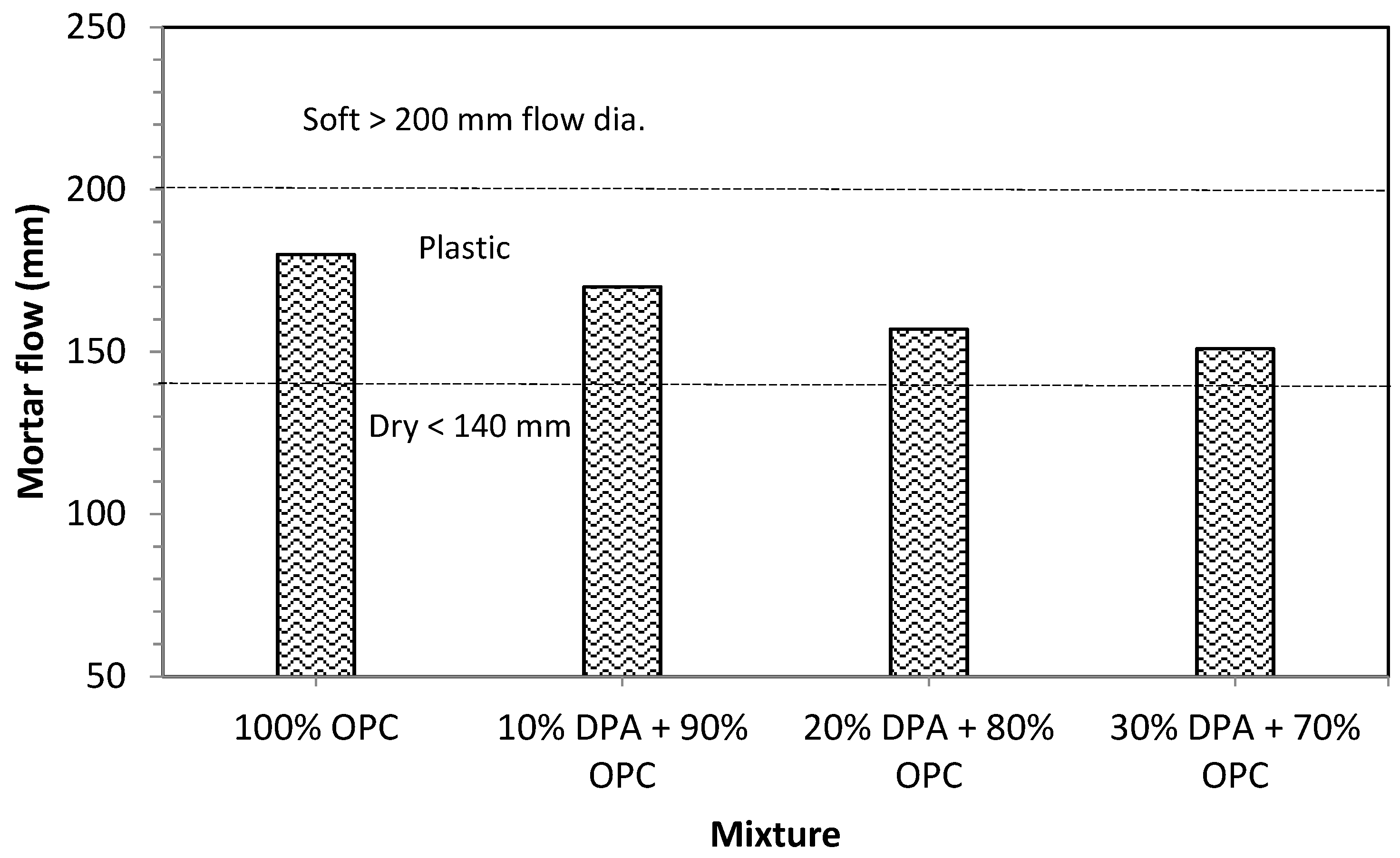
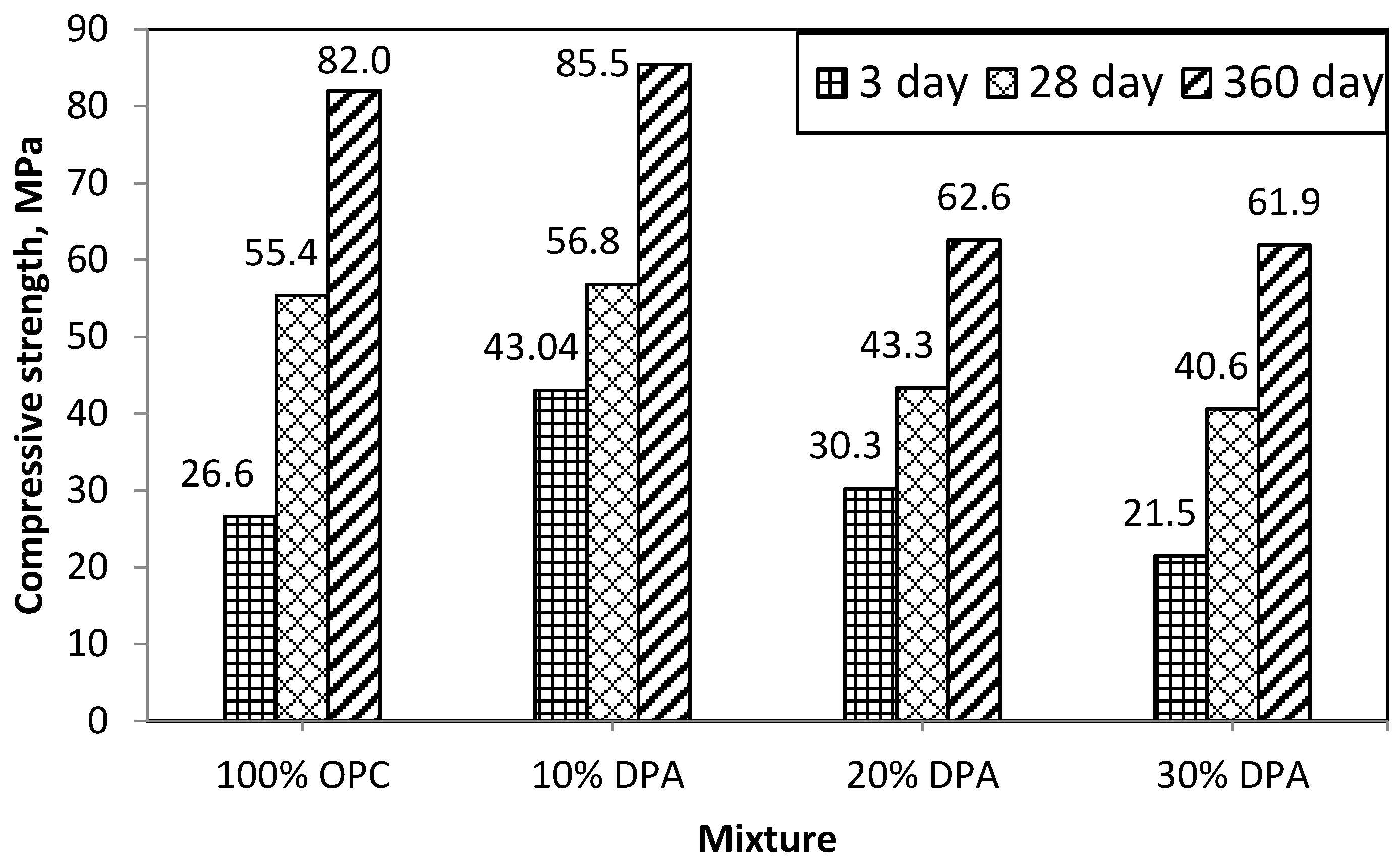
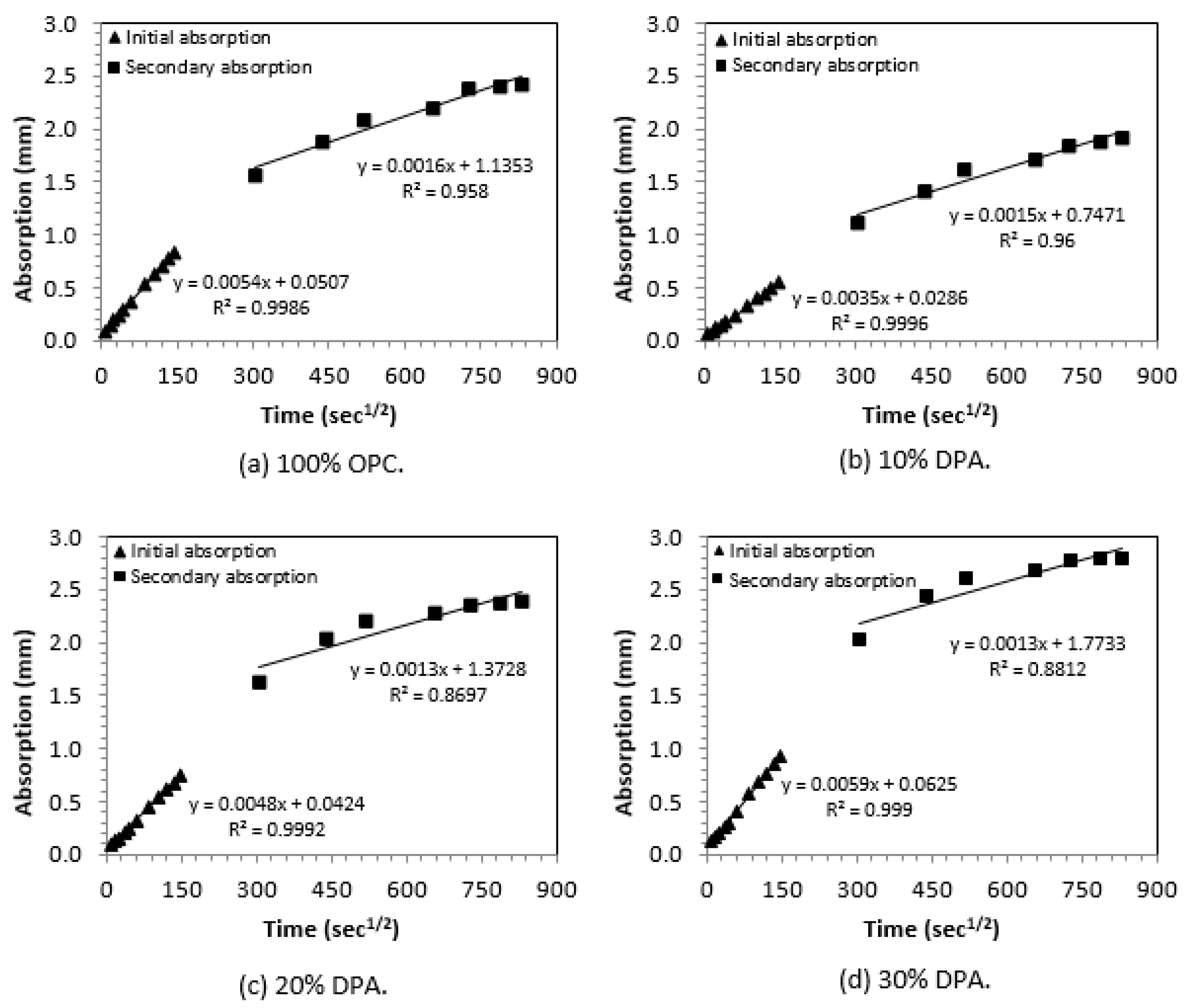
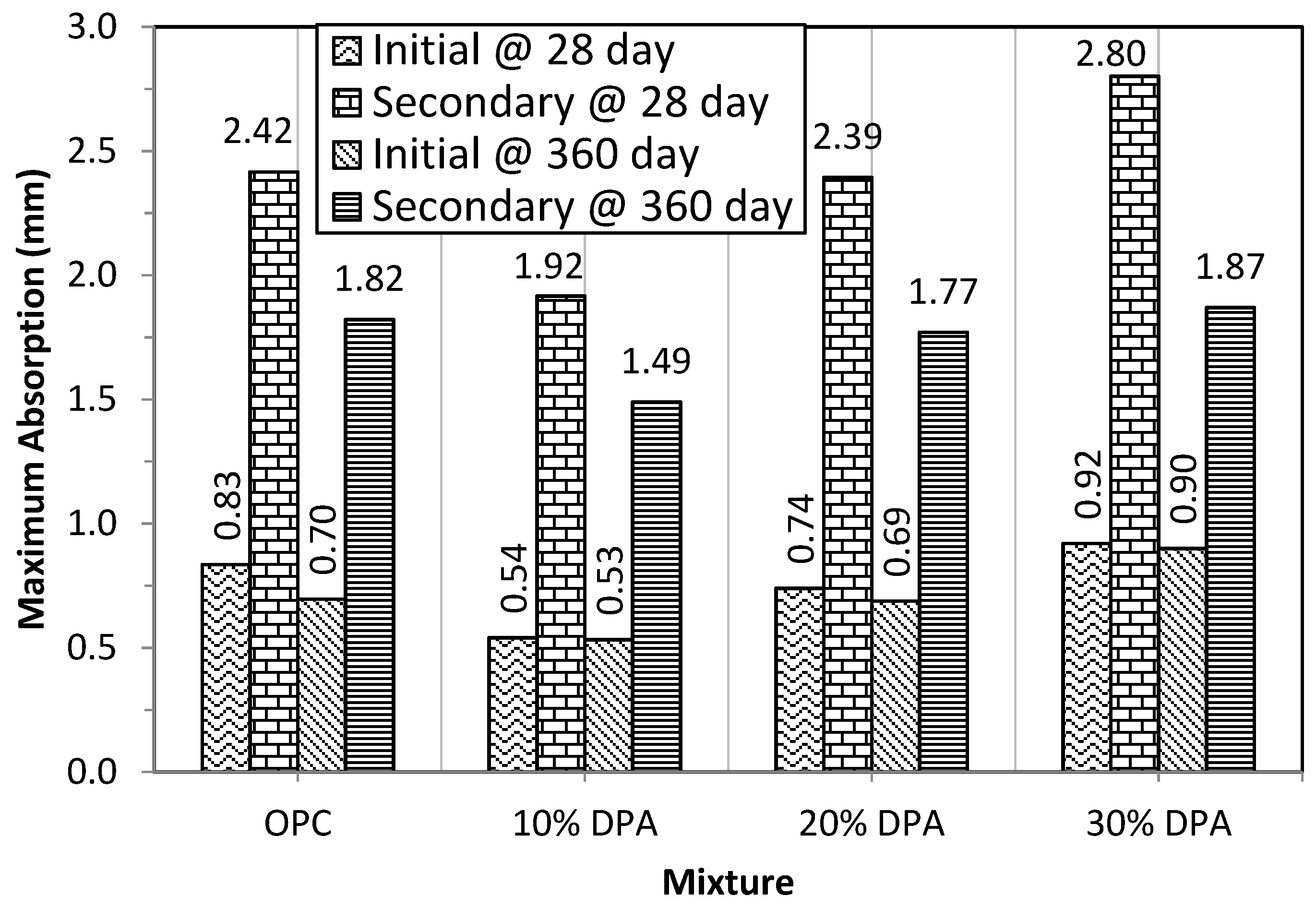
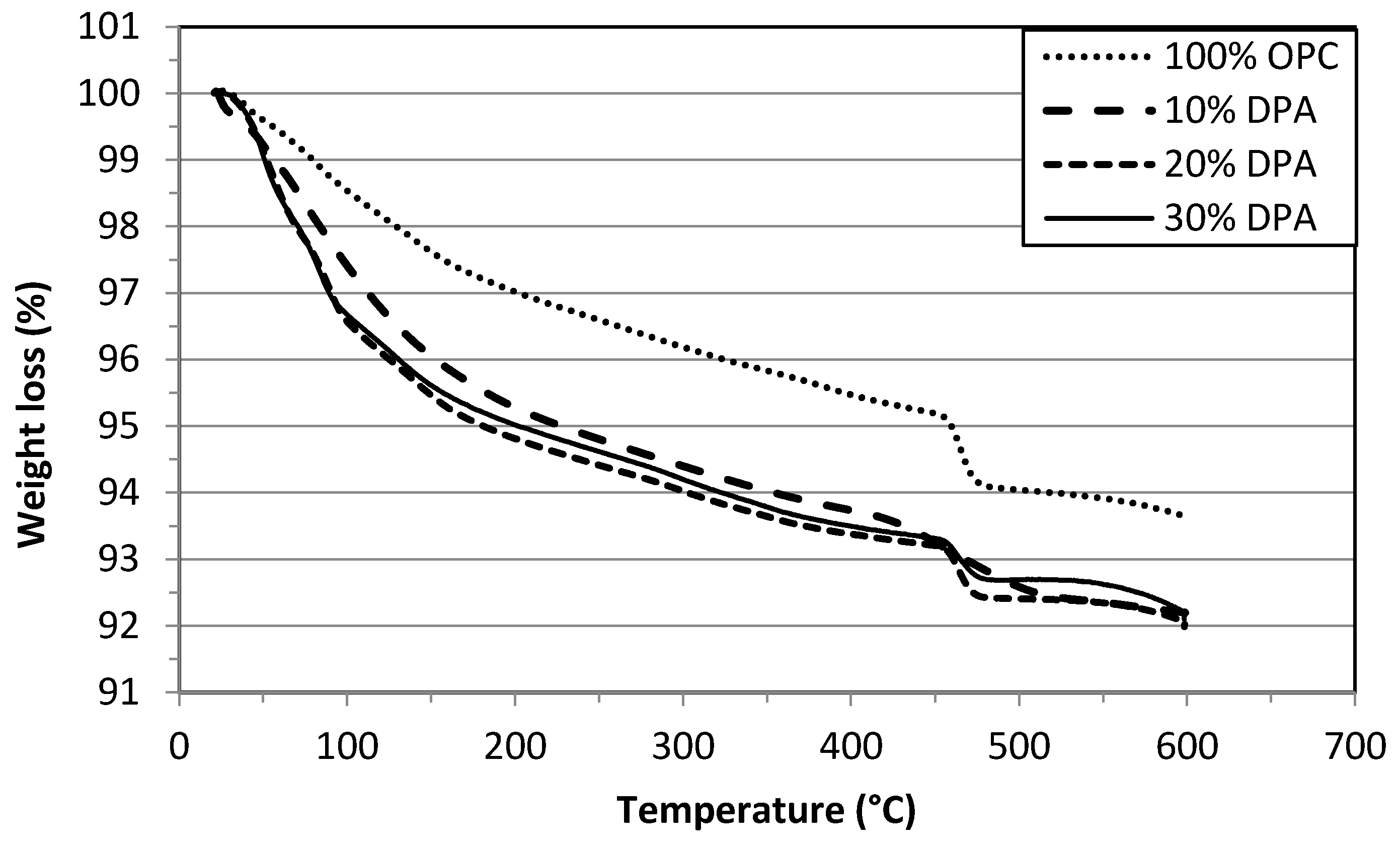
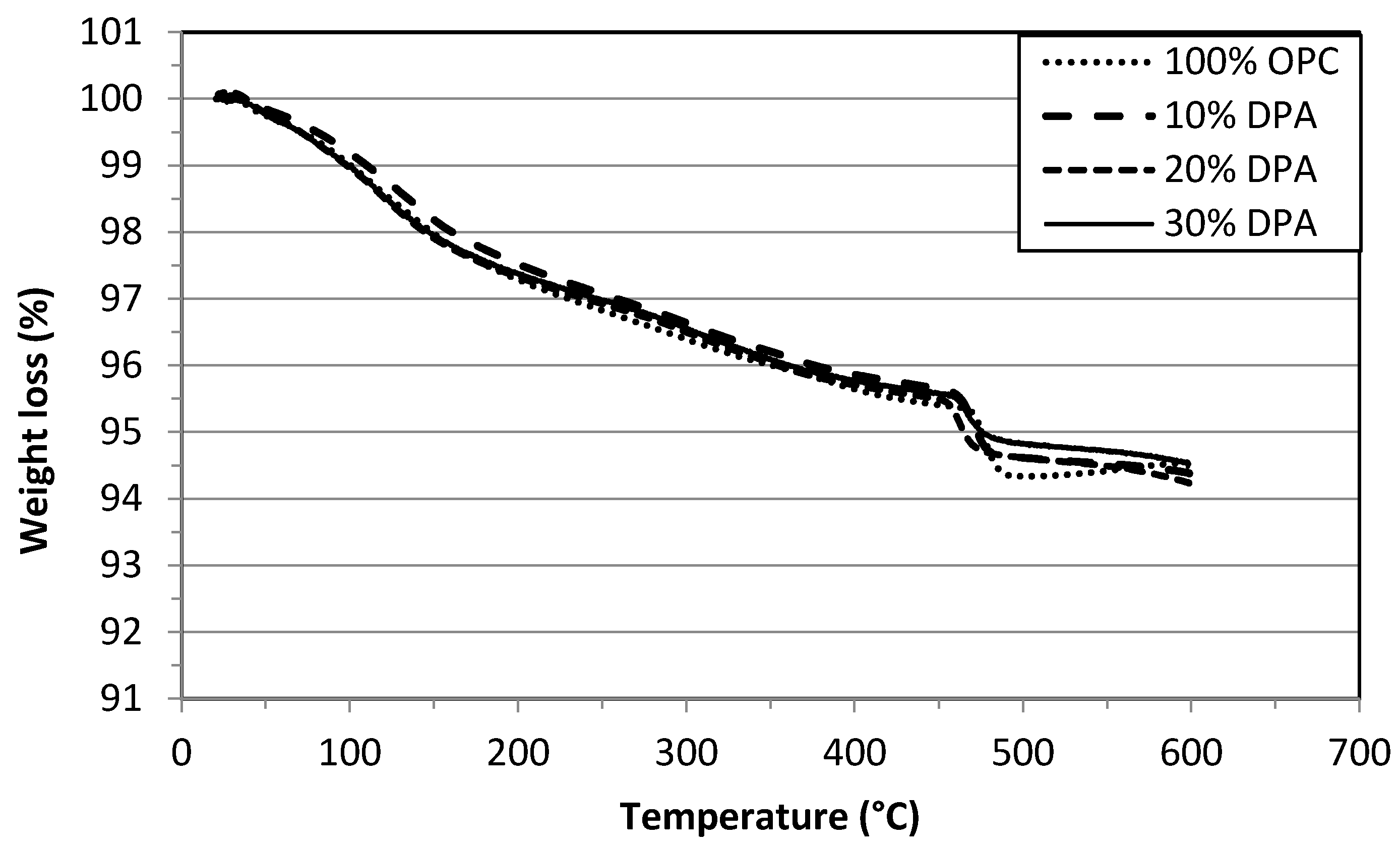
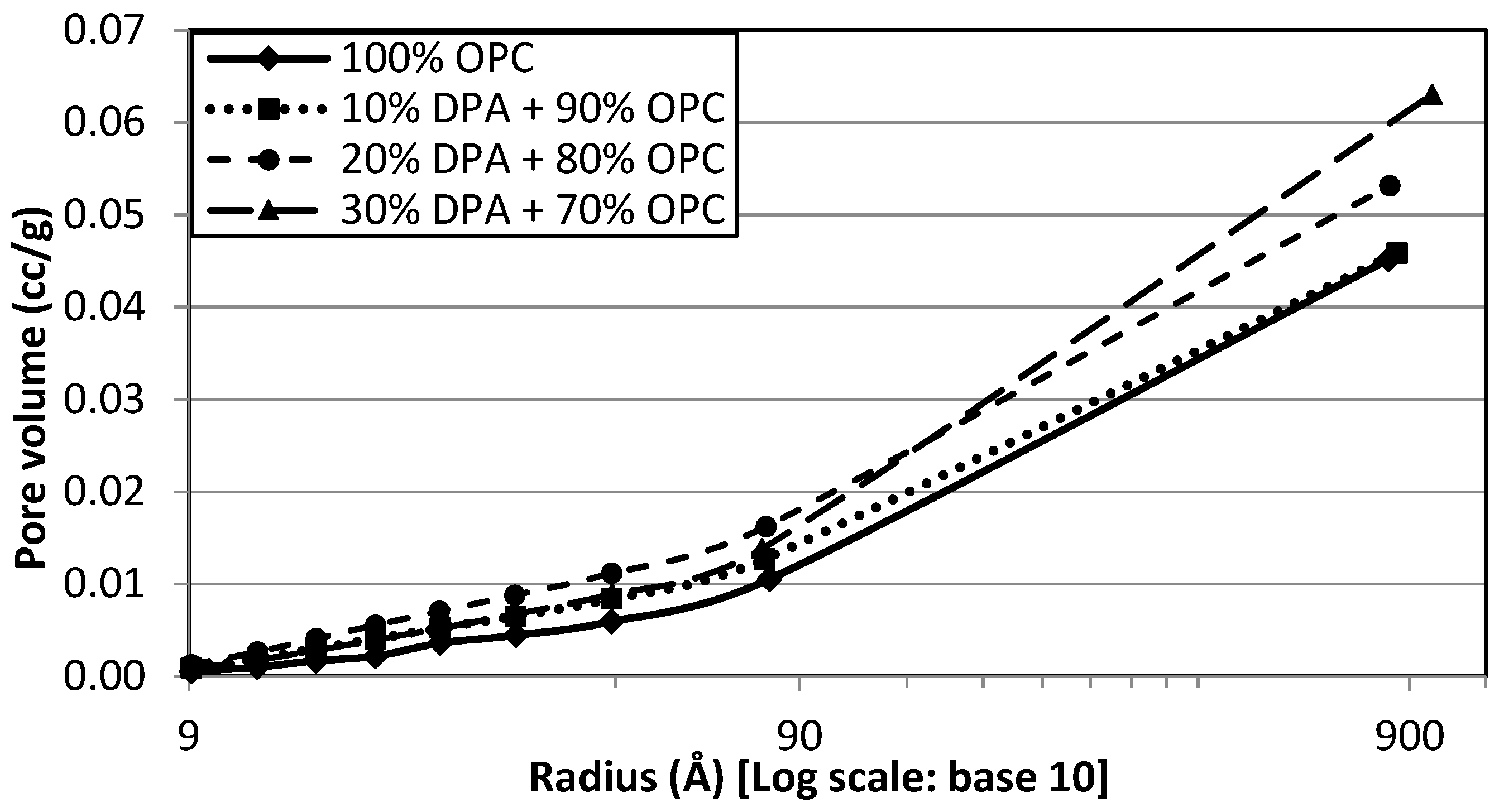
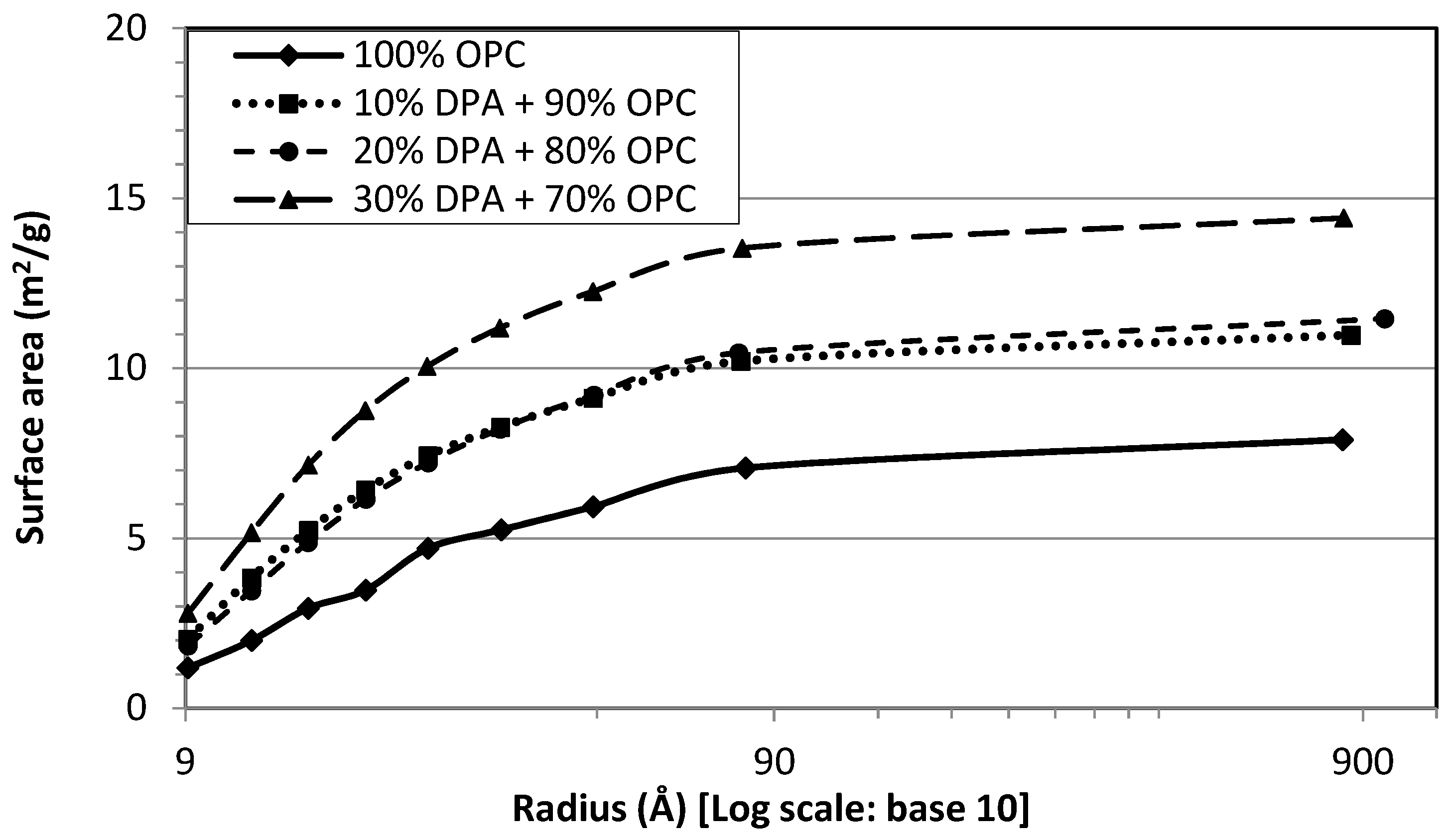
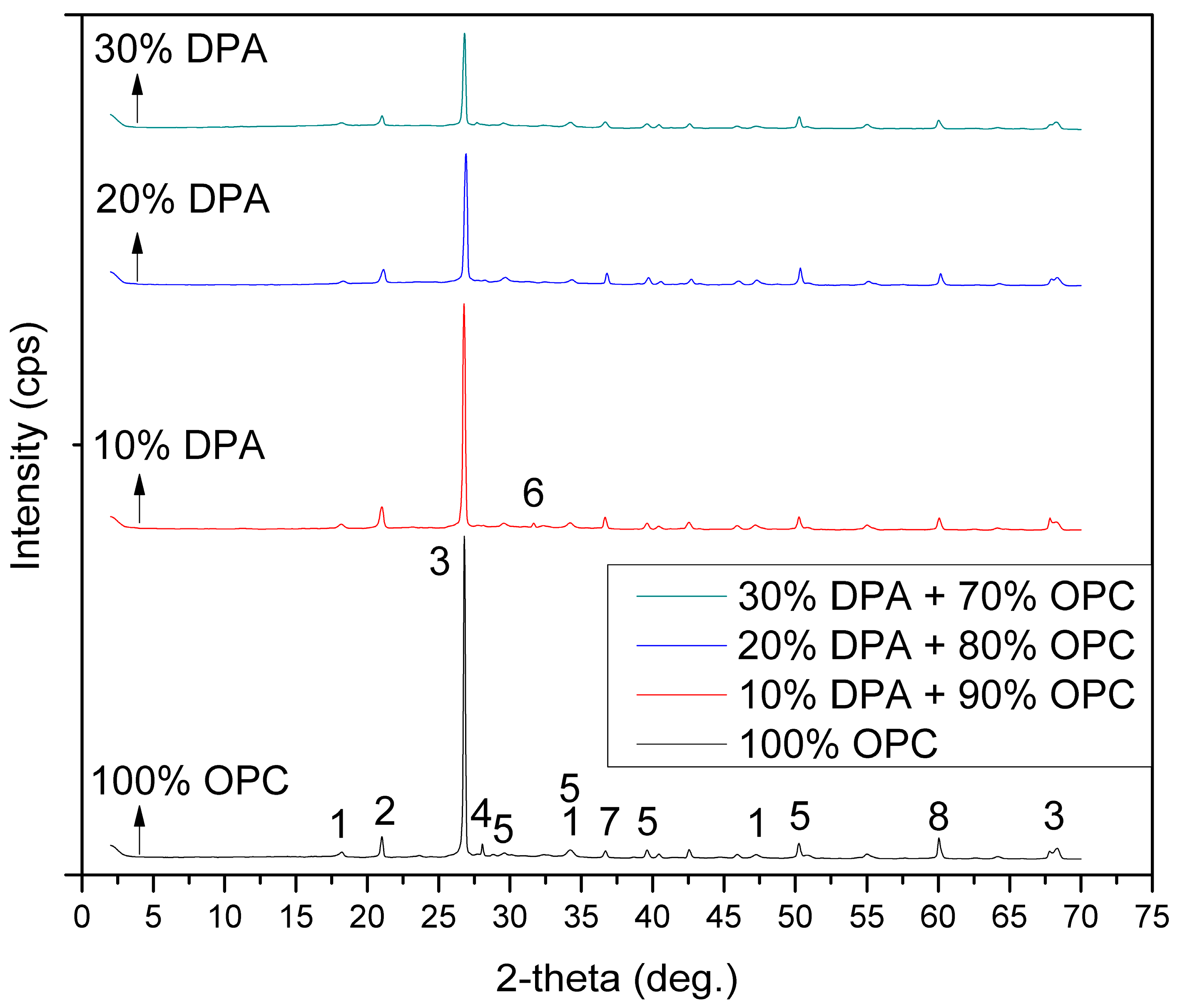
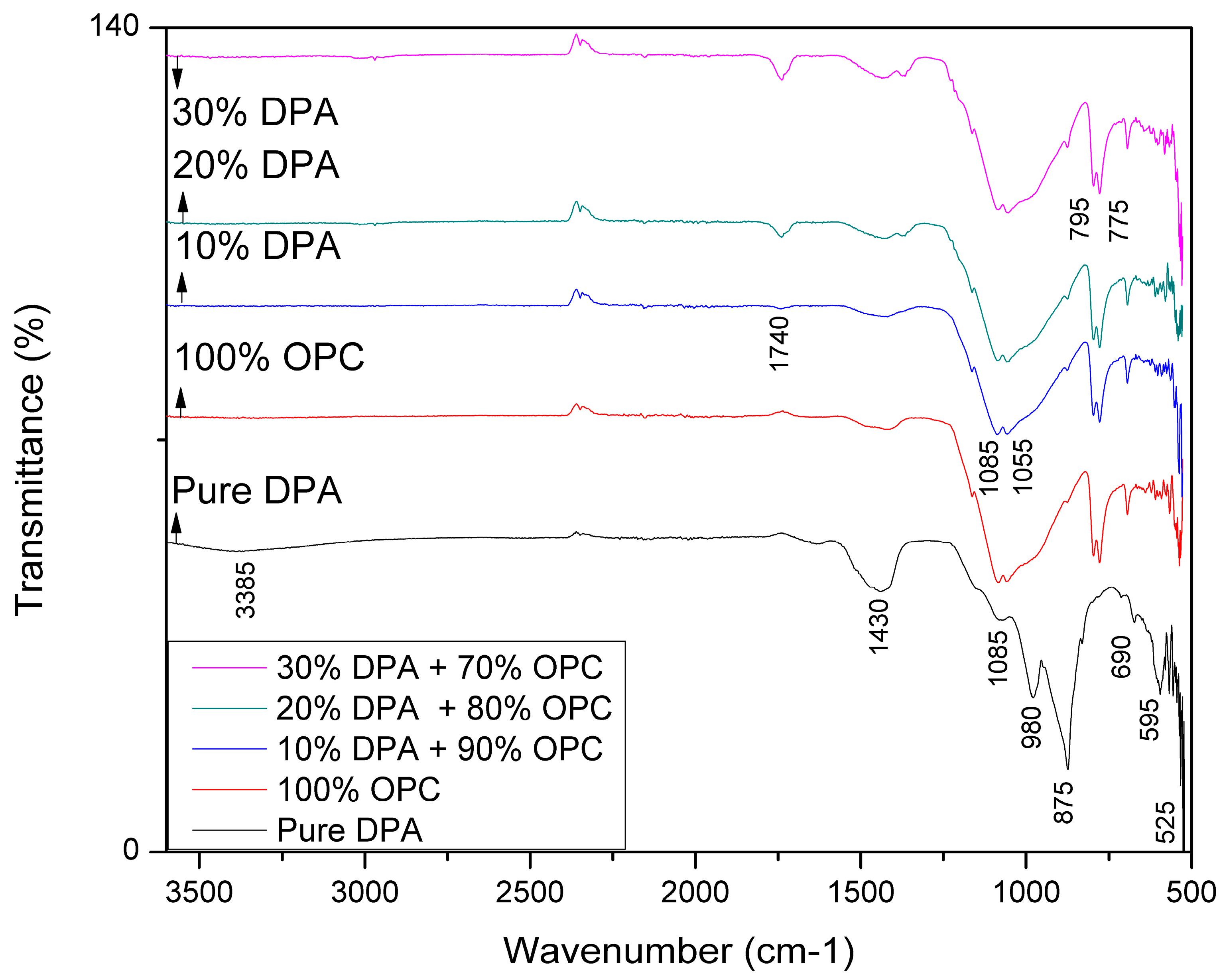
| Material | Oxides Wt. (%) | |||||||||||||
|---|---|---|---|---|---|---|---|---|---|---|---|---|---|---|
| SiO2 | CaO | MgO | Fe2O3 | K2O | Al2O3 | Cl | SO3 | C | Na2O | P2O5 | SrO | LOI | Sum | |
| DPA | 42.2 | 19.2 | 14.1 | 3.2 | 5.7 | 1.1 | 7.0 | 3.6 | 0.4 | 0.9 | 1.0 | 0.3 | 1.1 | 99.8 |
| OPC | 23 | 64.4 | 1.5 | 3.8 | 0.3 | 5.6 | - | - | - | 0.2 | - | - | 0.7 | 99.6 |
| Paste Type | Total WL (%) | Phase 1: 110–300 (°C) | Phase 2: 450–550 (°C) | ||
|---|---|---|---|---|---|
| Decomposition of C-S-H + C-A-S-H | Decomposition of Ca (OH)2 | ||||
| WL (%) | WL/WL in OPC | WL (%) | WL/WL in OPC | ||
| 100% OPC | 4.31 | 2.04 | 1.00 | 1.27 | 1.00 |
| 10% DPA | 4.54 | 2.50 | 1.23 | 0.90 | 0.71 |
| 20% DPA | 3.85 | 2.18 | 1.07 | 0.86 | 0.68 |
| 30% DPA | 3.71 | 2.14 | 1.05 | 0.69 | 0.54 |
| Paste Type | Total WL (%) | Phase 1: 110–300 (°C) | Phase 2: 450–550 (°C) | ||
|---|---|---|---|---|---|
| Decomposition of C-S-H + C-A-S-H | Decomposition of Ca (OH)2 | ||||
| WL (%) | WL/WL in OPC | WL (%) | WL/WL in OPC | ||
| 100% OPC | 4.24 | 2.27 | 1.00 | 0.99 | 1.00 |
| 10% DPA | 4.14 | 2.24 | 0.99 | 1.12 | 1.13 |
| 20% DPA | 4.16 | 2.15 | 0.95 | 0.99 | 1.00 |
| 30% DPA | 3.98 | 2.13 | 0.94 | 0.87 | 0.88 |
| Paste Type | Surface Area (m2/g) | Total Pore Volume (ml/g) | Average Pore Radius (nm) |
|---|---|---|---|
| 100% OPC | 7.900 | 0.046 | 23.221 |
| 10% DPA | 10.979 | 0.046 | 11.647 |
| 20% DPA | 11.461 | 0.053 | 11.647 |
| 30% DPA | 14.420 | 0.063 | 11.651 |
© 2018 by the authors. Licensee MDPI, Basel, Switzerland. This article is an open access article distributed under the terms and conditions of the Creative Commons Attribution (CC BY) license (http://creativecommons.org/licenses/by/4.0/).
Share and Cite
Nasir, M.; Al-Kutti, W. Performance of Date Palm Ash as a Cementitious Material by Evaluating Strength, Durability, and Characterization. Buildings 2019, 9, 6. https://doi.org/10.3390/buildings9010006
Nasir M, Al-Kutti W. Performance of Date Palm Ash as a Cementitious Material by Evaluating Strength, Durability, and Characterization. Buildings. 2019; 9(1):6. https://doi.org/10.3390/buildings9010006
Chicago/Turabian StyleNasir, Muhammad, and Walid Al-Kutti. 2019. "Performance of Date Palm Ash as a Cementitious Material by Evaluating Strength, Durability, and Characterization" Buildings 9, no. 1: 6. https://doi.org/10.3390/buildings9010006
APA StyleNasir, M., & Al-Kutti, W. (2019). Performance of Date Palm Ash as a Cementitious Material by Evaluating Strength, Durability, and Characterization. Buildings, 9(1), 6. https://doi.org/10.3390/buildings9010006





